Introduction to the 21st Century COE Program "Establishment of COE on Sustainable Energy System"
Energy and Environment in the 21st Century
It is forecast that energy consumption will increase dramatically in the 21st century because of rapid increase in population and further improvement in our living standard. Energy production and use are closely linked to local and global environmental problems. It is obligatory upon us to further develop environmentally friendly energy systems so as to keep the earth environment beautiful for future generations.
21st Century COE Program
Emphatic support for forming a worldclass educational and academic base was proposed by the Japanese Ministry of Education, Culture, Sports, Science and Technology as "The 21st Century COE (Center of Excellence) Program" and was put into practice from 2002 FY. In 2002 FY, 113 programs from 50 universities, including 11 programs from Kyoto University, were selected out of 464 applications from 163 universities.
To realize an environmentally friendly society and guarantee energy security, it is necessary to establish sustainable energy systems in the future. For this goal, the Graduate School of Energy Science, the Institute of Advanced Energy, and the Research Institute for Sustainable Humanosphere jointly proposed "Establishment of COE on Sustainable Energy Systems" for the 21COE program in 2002 FY, and fortunately, our proposal was accepted. The research and educational budget allocated for the last three years was about 860 million yen, and this will be continued for another two years.
Outline of 21COE Program on "Sustainable Energy Systems"
1. Research Program
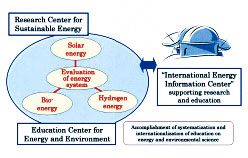
Figure 1: Outline of 21 COE program on "Sustainable Energy System"
Our 21COE program includes the establishment of both a research center and an educational center on energy and environment as shown in Figure 1. The research program consists of four research tasks: (1) solar energy system, (2) hydrogen energy system, (3) bioenergy system, and (4) evaluation of these various energy systems so as to achieve sustainable society harmonized with the environment. The solar energy task group investigates various applications of solar energy, consisting of three subtasks: advanced solar cells, plasma technique for nuclear fusion energy, and solar power station (SPS). The hydrogen energy task group studies hydrogen production, transport/storage and utilization in areas such as high-performance hydrogen engine and fuel cell systems, while the bio-energy task group studies the production of bio-energy from waste biomass to substitute energy from fossil fuel. The basic method applied to the conversion of waste biomass to bio-fuel is based on supercritical fluid technology.
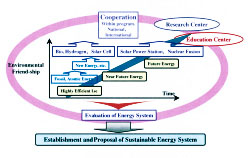
Figure 2: Final goal of 21 COE program on "Sustainable Energy System"
The evaluation task group, on the other hand, studies the evaluation methods of energy systems from various points of view such as energy efficiency, environmental impact, economics and social acceptability, etc. and application of the various energy systems. It is based on Life Cycle Assessment (LCA). The final goal of the 21 COE program on Sustainable Energy Systems is illustrated in Figure 2.
2. Educational Program
The new educational program will strengthen the development of students who can have a broad knowledge of both energy and environmental issues. Under such a new system, Ph.D. students not only learn technical aspects of energy science but also acquire the skills to solve problems under social constraints such as economic efficiency and social acceptability, etc. In addition, the students are trained to present and communicate fluently in English and to collaborate with colleagues, etc. so that they can play a leading role in various international communities in the future. We have published textbooks that facilitate systematic education of energy science. Furthermore, we are trying the systemization of curriculums, organizing the international school of energy science and providing a public advertisement-type research fund for doctoral students.
3. International Energy Information Center
To effectively promote and support those research and educational programs, the "International Energy Information Center" has been set up. It has a lot of roles such as surveying energy and environmental data, promoting research cooperation between industries-government-universities, holding the international and national symposiums, and establishing overseas offices, etc. Detailed information of 21COE program can be found on the homepage at http://energy.coe21.kyotou. ac.jp/e_index.html.
The Public Seminar
Formation of an energy saving-oriented society is first of all conditional on the awareness and cooperation of each and every citizen. In order to get as many people as possible involved with energy saving and environmental conservation by explaining energy and environment issues to citizens in simple terms, the 21COE Program also includes public seminars. Such seminars have already been staged in 35 out of the targeted 47 prefectures in Japan and have played an important part in deepening exchange with citizens.
Noteworthy Research
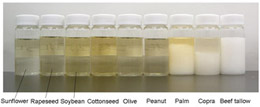 |
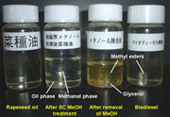 |
| Fig.1 A variety of vegetable oils and animal fats | Fig.2 Products after supercritical methanol treatment |
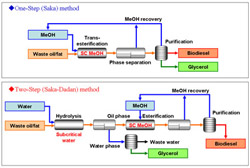
Fig.3 Biodiesel production processes with
supercritical methanol
Fig.1: These various oils and fats are successively converted into biodiesel by our developed supercritical methanol process.
Fig.2: Oil/fat feedstocks can be converted into biodiesel fuel and collected as oil phase by a simple phase separation. In the meantime, methanol phase including glycerol as a co-product can be separated.
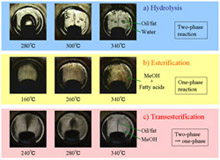
Fig.4 In-situ observations for the oil/fat reactions
through a sapphire glass
Fig.3: One-step method (called as Saka Process) is based on transesterification of oils/fats (triglycerides), whereas two-step method (called as Saka-Dadan Process) is on hydrolysis of oils/fats in subcritical water to fatty acids which are subsequently converted to biodiesel fuel through methyl esterification in supercritical methanol.
Fig.4: Although transesterification of oils/fats proceeds through one-phase reaction at high temperatures, it does heterogeneously at low temperature in supercritical methanol.
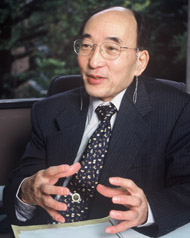
Mikio Kasahara
Born in 1942.
Specialized Research Field: Atmospheric Environmental Engineering, Aerosol Science,Energy Science
Graduate of the master's program, Graduate School of Engineering, Kyoto University
D.Eng., Kyoto University
Professor, Graduate School of Energy Science, Kyoto University
URL ENERGY & ENVIRONMENT LABORATORY (External Link)
"The question that we scientists must face is to decide which areas of research we should be delving in for the 21COE project. We get a lot of ideas and courage by talking to all the citizens who attend these public seminars."
Prof. Kasahara is nothing if not a busy man. He wears three important hats: project leader for 21st Century COE, Dean of the Graduate School of Energy Science and head of the Atmospheric Environmental Impacts of Aerosols in East Asia research project. And yet, he speaks of his time spent in such research and supervisions with a sense of joy and relaxation, as though it were nowhere near as arduous as it really is. This feeling of happiness most likely derives from the fact that all of the projects with which he is currently associated are ultimately aimed at achieving the same thing: offering environmentally friendly lifestyles, as opposed to merely developing technologies or explaining phenomena. Environmental friendliness, however, carries the implication of inconvenience to humans, a condition that the Professor believes can be significantly eased through developing new technologies, which in turn will find greater application the more basic research is done.
The Kyoto Protocol took effect at last in February. It is the mission of Kyoto University, located within the city of Kyoto, the very site of the COP3, to cause people to think about environmental issues. And we consider our support of Prof. Kasahara in his myriad projects to be part and parcel of this social obligation that we bear..
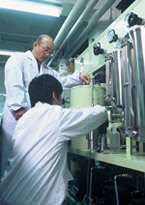
Prof. Saka providing guidance during an experiment with supercritical liquid.

